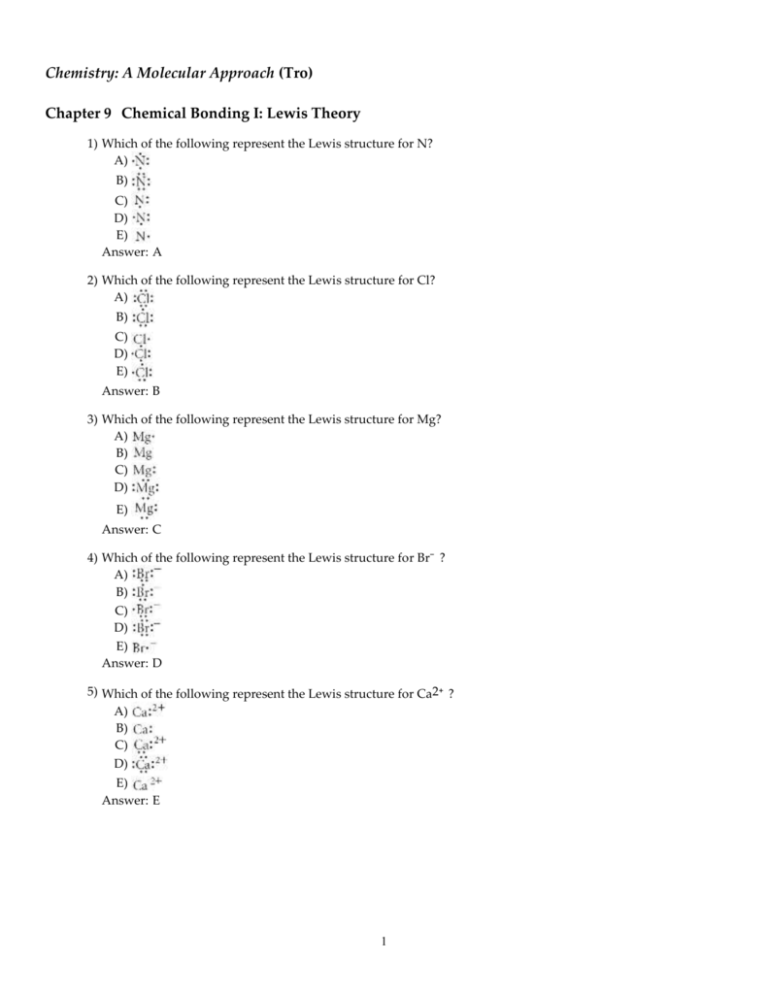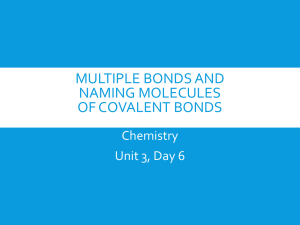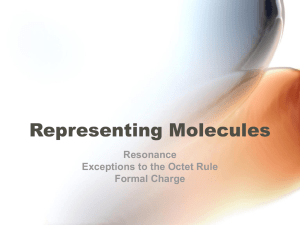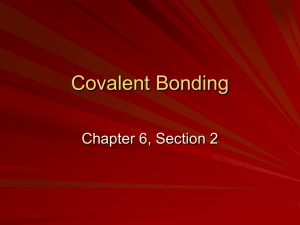Chemical Bonding: Lewis Theory Practice Questions
advertisement

Chemistry: A Molecular Approach (Tro) Chapter 9 Chemical Bonding I: Lewis Theory 1) Which of the following represent the Lewis structure for N? A) B) C) D) E) Answer: A 2) Which of the following represent the Lewis structure for Cl? A) B) C) D) E) Answer: B 3) Which of the following represent the Lewis structure for Mg? A) B) C) D) E) Answer: C 4) Which of the following represent the Lewis structure for Br⁻ ? A) B) C) D) E) Answer: D 5) Which of the following represent the Lewis structure for Ca2⁺ ? A) B) C) D) E) Answer: E 1 6) Which of the following represent the Lewis structure for S 2⁻ ? A) B) C) D) E) Answer: A 7) Use Lewis theory to determine the chemical formula for the compound formed between Ca and N. A) CaN B) Ca3N2 C) CaN2 D) Ca2N E) Ca2N3 Answer: B 8) Use Lewis theory to determine the chemical formula for the compound formed between Rb and S. A) RbS B) RbS2 C) Rb2S D) Rb2S3 E) Rb3S2 Answer: C 9) Use Lewis theory to determine the chemical formula for the compound formed between Mg and Br. A) MgBr B) Mg2Br3 C) Mg3Br2 D) MgBr2 E) Mg2Br Answer: D 10) Use Lewis theory to determine the chemical formula for the compound formed between Al and O. A) Al3O2 B) Al2O3 C) AlO2 D) Al2O E) AlO Answer: B 11) Which of the following statements is TRUE? A) A covalent bond is formed through the transfer of electrons from one atom to another. B) A pair of electrons involved in a covalent bond are sometimes referred to as "lone pairs." C) It is not possible for two atoms to share more than 2 electrons. D) Single bonds are shorter than double bonds. E) A covalent bond has a lower potential energy than the two separate atoms. Answer: E 2 12) Which of the following statements is TRUE? A) An ionic bond is much stronger than most covalent bonds. B) An ionic bond is formed through the sharing of electrons. C) Ionic compounds at room temperature typically conduct electricity. D) Once dissolved in water, ionic compounds rarely conduct electricity. E) None of the above are true. Answer: A 13) Which of the following reactions represent the lattice energy of Li 2O (H°latt)? A) Li2O(s) → 2 Li⁺ (g) + O2⁻ (g) B) 2 Li⁺ (aq) + O2⁻ (aq) → Li2O(s) C) 2 Li⁺ (g) + O2⁻ (g) → Li2O(s) D) Li2O(s) → 2 Li⁺ (aq) + O2⁻ (aq) E) 2 Li(s) + O2(g) → Li2O(s) Answer: C 14) Which of the following reactions represent the lattice energy of CaS (H°latt)? A) Ca(s) + S(s) → CaS(s) B) CaS(s) → Ca(s) + S(s) C) Ca2⁺ (aq) + S2⁻ (aq) → CaS(s) D) Ca2⁺ (g) + S2⁻ (g) → CaS(s) E) CaS(s) → Ca2⁺ (aq) + S2⁻ (aq) Answer: D 15) Which of the following reactions represent the lattice energy of RbI (H°latt)? A) 1 I2(g) → RbI(s) 2 B) RbI(s) → Rb⁺ (g) + I⁻ (g) C) Rb(s) + RbI(s) → Rb(s) + I2(g) D) RbI(s) → Rb⁺ (aq) + I⁻ (aq) E) Rb⁺ (g) + I⁻ (g) → RbI(s) Answer: E 16) Place the following in order of decreasing magnitude of lattice energy. K2O Rb2S Li2O A) Li2O > K2O > Rb2S B) Li2O > Rb2S > K2O C) Rb2S > K2O > Li2O D) Rb2S > Li2O > K2O E) K2O > Li2O > Rb2S Answer: A 3 17) Place the following in order of decreasing magnitude of lattice energy. NaF RbBr KCl A) RbBr > NaF > KCl B) NaF > KCl > RbBr C) KCl > NaF > RbBr D) NaF > RbBr > KCl E) RbBr > KCl > NaF Answer: B 18) Place the following in order of increasing magnitude of lattice energy. CaO MgO SrS A) MgO < CaO < SrS B) SrS < MgO < CaO C) SrS < CaO < MgO D) CaO < MgO < SrS E) CaO < SrS < MgO Answer: C 19) Place the following in order of increasing magnitude of lattice energy. MgO LiI CaS A) CaS < MgO < LiI B) LiI < CaS < MgO C) MgO < CaS < LiI D) LiI < MgO < CaS E) MgO < LiI < CaS Answer: D 20) Place the following in order of decreasing magnitude of lattice energy. KF MgS RbI A) RbI > KF > MgS B) RbI > MgS > KF C) MgS > RbI > KF D) KF > RbI > MgS E) MgS > KF > RbI Answer: E 21) Choose the compound below that should have the highest melting point according to the ionic bonding model. A) AlN B) MgO C) NaF D) CaS E) RbI Answer: A 4 22) Choose the compound below that should have the highest melting point according to the ionic bonding model. A) SrI2 B) MgF2 C) CaCl2 D) SrF2 E) SrBr2 Answer: B 23) Choose the compound below that should have the lowest melting point according to the ionic bonding model. A) LiF B) NaCl C) CsI D) KBr E) RbI Answer: C 24) Place the following elements in order of increasing electronegativity. K Cs P A) P < K < Cs B) K < P < Cs C) Cs < P < K D) Cs < K < P E) P < Cs < K Answer: D 25) Place the following elements in order of decreasing electronegativity. S Cl A) Se > S > Cl B) Cl > Se > S C) Se > Cl > S D) S > Cl > Se E) Cl > S > Se Answer: E Se 26) Place the following elements in order of increasing electronegativity. Sr N Na A) Sr < Na < N B) Na < N < Sr C) Sr < N < Na D) N < Sr < Na E) N < Na < Sr Answer: A 5 27) Choose the bond below that is most polar. A) C-N B) C-F C) C-O D) C-C E) F-F Answer: B 28) Choose the bond below that is most polar. A) H-I B) H-Br C) H-F D) H-Cl E) C-H Answer: C 29) Choose the bond below that is least polar. A) P-F B) C-Br C) C-F D) C-I E) C-Cl Answer: D 30) Using periodic trends, place the following bonds in order of increasing ionic character. S-F Se-F O-F A) Se-F < S-F < O-F B) S-F < Se-F < O-F C) O-F < Se-F < S-F D) Se-F < O-F < S-F E) O-F < S-F < Se-F Answer: E 31) Using periodic trends, place the following bonds in order of decreasing ionic character. Sb-Cl P-Cl As-Cl A) Sb-Cl > As-Cl > P-Cl B) As-Cl > Sb-Cl > P-Cl C) Sb-Cl > P-Cl > As-Cl D) P-Cl > As-Cl > Sb-Cl E) Sb-Cl > P-Cl > As-Cl Answer: A 6 32) Using periodic trends, place the following bonds in order of increasing ionic character. Si-P Si-Cl Si-S A) Si-P < Si-Cl < Si-S B) Si-P < Si-S < Si-Cl C) Si-S < Si-Cl < Si-P D) Si-Cl < Si-P < Si-S E) Si-Cl < Si-S < Si-P Answer: B 33) Which molecule or compound below contains a pure covalent bond? A) Li2CO3 B) SCl6 C) Cl2 D) PF3 E) NaCl Answer: C 34) Which molecule or compound below contains a polar covalent bond? A) C2H4 B) ZnS C) LiI D) NCl3 E) AgCl Answer: D 35) Which molecule or compound below contains an ionic bond? A) CO2 B) C2Cl4 C) SiF4 D) OCl2 E) NH4NO3 Answer: E 36) Which of the following elements can form compounds with an expanded octet? A) Se B) C C) Li D) F E) All of the above elements can form compounds with an expanded octet. Answer: A 37) Which of the following elements can form compounds with an expanded octet? A) N B) Br C) F D) Be E) None of the above can form compounds with an expanded octet. Answer: B 7 38) How many of the following elements can form compounds with an expanded octet? I O Cl Xe A) 2 B) 0 C) 3 D) 1 E) 4 Answer: C 39) How many of the following elements can form compounds with an expanded octet? Pb Kr Si B A) 0 B) 1 C) 2 D) 3 E) 4 Answer: D 40) Choose the bond below that is the strongest. A) C-F B) C=O C) C-I D) I-I E) C≡N Answer: E 41) Choose the bond below that is the strongest. A) N=O B) N-I C) N-O D) N-S E) N=N Answer: A 42) Choose the bond below that is the weakest. A) Na-Cl B) I-I C) C=N D) Li-F E) C=O Answer: B 43) Choose the bond below that is the weakest. A) C≡O B) N≡N C) C-I D) C=S E) K-Cl Answer: C 8 44) Place the following in order of increasing bond length. C-F C-S C-Cl A) C-S < C-Cl < C-F B) C-Cl < C-F < C-S C) C-F < C-S < C-Cl D) C-F < C-Cl < C-S E) C-S < C-F < C-Cl Answer: D 45) Place the following in order of decreasing bond length. H-F H-I H-Br A) H-F > H-Br > H-I B) H-I > H-F > H-Br C) H-I > H-Br > H-F D) H-Br > H-F > H-I E) H-F > H-I > H-Br Answer: C 46) Place the following in order of decreasing XO bond length, where "X" represents the central atom in each of the following compounds or ions. SiO32⁻ CO2 CO32⁻ A) CO2 > SiO32⁻ > CO32⁻ B) CO2 > CO32⁻ > SiO32⁻ C) CO32⁻ > CO2 > SiO32⁻ D) CO32⁻ > SiO32⁻ > CO2 E) SiO32⁻ > CO32⁻ > CO2 Answer: E 47) Place the following in order of increasing NO bond length. NO2⁻ NO3⁻ NO A) NO < NO2⁻ < NO3⁻ B) NO2⁻ < NO3⁻ < NO C) NO3⁻ < NO < NO2⁻ D) NO < NO3⁻ < NO2⁻ E) NO3⁻ < NO2⁻ < NO Answer: A 9 48) Use the bond energies provided to estimate H°rxn for the reaction below. Bond Cl-Cl P-Cl PCl3(g) + Cl2(g) → PCl5(l) Bond Energy (kJ/mol) 243 331 H°rxn= ? A) -243 kJ B) -419 kJ C) -662 kJ D) -67 kJ E) -905 kJ Answer: B 49) Use the bond energies provided to estimate H°rxn for the reaction below. Bond Br-Br C≡C C-C C-Br C-H 2 Br2(l) + C2H2(g) → C2H2Br4(l) Bond Energy (kJ/mol) 193 837 347 276 414 H°rxn= ? A) +407 kJ B) -324 kJ C) -228 kJ D) +573 kJ E) -648 kJ Answer: C 50) Use the bond energies provided to estimate H°rxn for the reaction below. CH3OH(l) + 2 O2(g) → CO2(g) + 2 H2O(g) H°rxn= ? Bond C-H C-O C=O O=O O-H Bond Energy (kJ/mol) 414 360 799 498 464 A) +473 kJ B) -91 kJ C) -486 kJ D) -392 kJ E) +206 kJ Answer: D 10 51) Use the bond energies provided to estimate H°rxn for the reaction below. XeF2 + 2 F2 → Bond Xe-F F-F H°rxn= ? XeF6 Bond Energy (kJ/mol) 147 159 A) -429 kJ B) +159 kJ C) -660 kJ D) +176 kJ E) -270 kJ Answer: E 52) Use the bond energies provided to estimate H°rxn for the reaction below. C2H4(g) + H2(g) Bond C-C C-H C=C C≡C H-H → C2H6(g) H°rxn= ? Bond Energy (kJ/mol) 347 414 611 837 436 A) -128 kJ B) +98 kJ C) +700 kJ D) -102 kJ E) -166 kJ Answer: A 53) Use the data given below to construct a Born-Haber cycle to determine the lattice energy of CaO. Ca(s) → Ca(g) Ca(g) → Ca⁺ (g) + e⁻ Ca⁺ (g) → Ca2⁺ (g) + e⁻ 2 O(g) → O2(g) O(g) + e⁻ → O⁻ (g) O⁻ (g) + e⁻ → O2⁻ (g) 1 Ca(s) + O2(g) → CaO(s) 2 A) -3414 kJ B) +1397 kJ C) -2667 kJ D) +3028 kJ E) -2144 kJ Answer: A H°(kJ) 193 590 1010 -498 -141 878 -635 11 54) Use the data given below to construct a Born-Haber cycle to determine the electron affinity of Br. K(s) → K(g) K(g) → K⁺ (g) + e⁻ Br2(l) → 2 Br(g) 1 Br2(g) → KBr (s) 2 KBr(s) → K⁺ (g) + Br⁻ (g) K(s) + H°(kJ) 89 419 193 -394 674 A) -885 kJ B) -325 kJ C) +367 kJ D) -464 kJ E) +246 kJ Answer: B 55) Use the data given below to construct a Born-Haber cycle to determine the heat of formation of KCl. K(s) → K(g) K(g) → K⁺ (g) + e⁻ Cl2(g) → 2 Cl(g) Cl(g) + e⁻ → Cl⁻ (g) KCl(s) → K⁺ (g) + Cl⁻ (g) H°(kJ) 89 418 244 -349 717 A) -1119 kJ B) -997 kJ C) -437 kJ D) +631 kJ E) +158 kJ Answer: C 56) Use the data given below to construct a Born-Haber cycle to determine the bond energy of O2. Na(s) → Na(g) Na(g) → Na⁺ (g) + e⁻ O(g) + e⁻ → O⁻ (g) O⁻ (g) + e⁻ → O2⁻ (g) 1 O2(g) → Na2O(s) 2 2 Na⁺ (g) + O2⁻ (g) → Na2O(s) 2 Na(s) + H°(kJ) 107 496 -141 878 -416 -2608 A) 426 kJ B) 249 kJ C) 852 kJ D) 498 kJ E) 356 kJ Answer: D 12 57) Use the data given below to construct a Born-Haber cycle to determine the second ionization energy of Ca. Ca(s) → Ca(g) Ca(g) → Ca⁺ (g) + e⁻ 2 O(g) → O2(g) H°(kJ) 193 590. -498 O(g) + e⁻ → O⁻ (g) O⁻ (g) + e⁻ → O2⁻ (g) 1 Ca(s) + O2(g) → CaO(s) 2 Ca2⁺ (g) + O2⁻ (g) → CaO(s) -141 878 -635 -3414 A) 1010 kJ B) 1757 kJ C) 1508 kJ D) -3027 kJ E) -1514 kJ Answer: A 58) Which of the following processes are exothermic? A) Cl2(g) → 2Cl(g) B) Br(g) + e⁻ → Br⁻ (g) C) Li(s) → Li(g) D) NaF(s) → Na⁺ (g) + F⁻ (g) E) None of the above are exothermic. Answer: B 59) Which of the following processes are exothermic? A) the second ionization energy of Mg. B) the sublimation of Li. C) the bond energy of I2 D) the heat of formation of NaBr. E) None of the above are exothermic. Answer: D 60) Which of the following processes are endothermic? A) K⁺ (g) + I⁻ (g) → KI(s) B) 2 Br(g) → Br2(g) C) Ca(s) → Ca(g) D) O2(g) → Na2O(s) E) None of the above are endothermic. Answer: C 2 Na(s) + 61) Which of the following processes are endothermic? A) the lattice energy of LiCl B) the ionization energy of potassium C) the heat of formation of CaS D) the formation of an F-F bond from two separate F atoms. E) None of the above are endothermic. Answer: E 13 62) Draw the Lewis structure for SO42⁻ . How many equivalent resonance structures can be drawn? A) 6 B) 2 C) 4 D) 3 E) 8 Answer: A 63) Draw the Lewis structure for NO2⁻ including any valid resonance structures. Which of the following statements is TRUE? A) The nitrite ion contains one N-O single bond and one N=O double bond. B) 1 The nitrite ion contains two N-O bonds that are equivalent to 1 bonds. 2 C) The nitrite ion contains two N=O double bonds. D) The nitrite ion contains two N-O single bonds. E) None of the above are true. Answer: B 64) Draw the Lewis structure for PO3⁻ including any valid resonance structures. Which of the following statements is TRUE? A) The PO3⁻ ion contains one P-O single bond and two P=O double bonds. B) The PO3⁻ ion contains two P-O single bonds and one P=O double bonds C) 2 bonds. 3 D) The PO3⁻ ion contains two P-O single bonds and one P≡O triple bond. E) None of the above are true. Answer: C The PO3⁻ ion contains three identical bonds, all equivalent to 1 65) Which of the following resonance structures for OCN⁻ will contribute most to the correct structure of OCN⁻ ? A) O(2 lp)=C=N(2 lp) B) O(1 lp)≡C-N(3 lp) C) O(1 lp)=C(2 lp)=N(1 lp) D) image of ...O(with 3 lone pair)-C≡N(with 1 lone pair) E) They all contribute equally to the correct structure of OCN⁻ . Answer: D 66) Using Lewis structures and formal charge, which of the following ions is most stable? OCN⁻ ONC⁻ NOC⁻ A) OCN⁻ B) ONC⁻ C) NOC⁻ D) None of these ions are stable according to Lewis theory. E) All of these compounds are equally stable according to Lewis theory. Answer: A 14 67) Draw the best Lewis structure for Cl3⁻ . What is the formal charge on the central Cl atom? A) -1 B) 0 C) +1 D) +2 E) -2 Answer: A 68) Draw the best Lewis structure for the free radical, NO2. What is the formal charge on the N? A) 0 B) +1 C) -1 D) +2 E) -2 Answer: B 69) Draw the best Lewis structure for BrO4⁻ and determine the formal charge on bromine and one of the oxygen atoms. A) -1 B) +1 C) 0 D) +2 E) +3 Answer: C 70) Choose the best Lewis structure for BeF2. A) B) C) D) E) Answer: D 71) Choose the best Lewis structure for OCl2. A) B) C) D) E) Answer: E 15 72) Choose the best Lewis structure for CH2Cl2. A) B) C) D) E) Answer: B 73) Choose the best Lewis structure for XeI2. A) B) C) D) E) Answer: C 16 74) Choose the best Lewis structure for ICl5. A) B) C) D) E) Answer: D 17 75) Choose the best Lewis structure for SF4. A) B) C) D) E) Answer: E 18 76) Choose the best Lewis structure for BF3. A) B) C) D) E) Answer: B 77) Choose the best Lewis structure for NO3⁻ . A) B) C) D) E) Answer: A 19 78) Choose the best Lewis structure for SO32⁻ . A) B) C) D) E) Answer: A 20 79) Choose the best Lewis structure for PO33⁻ . A) B) C) D) E) Answer: C 21 80) Choose the best Lewis structure for SeO42⁻ . A) B) C) D) E) Answer: D 22 81) Choose the best Lewis structure for NH4⁺ . A) B) C) D) E) Answer: E 82) Draw the Lewis structure for BrO3⁻ . Make sure to include any important resonance structures. Answer: There should be 3 equivalent resonance structures drawn, each containing 1 single Br-O bond and 2 double Br-O bonds. 83) Describe the difference between a pure covalent bond and a polar covalent bond. Answer: A pure covalent bond occurs when bonding electrons are shared equally (or very close to it) as in the N-N bond. A polar covalent bond is formed between 2 atoms of differing electronegativities. The bonding electrons are unequally shared between the two atoms as in the CO molecule. 84) Draw the Lewis structure for the acetate ion, CH3CO2⁻ , including any important resonance structures. Label each atom with its formal charge. Answer: There should be two equivalent resonance structures drawn. All atoms should have a formal charge of "0" except the singly bonded O will have a formal charge of -1. 85) Explain why the lattice energy of MgS is approximately 4 times larger than that of NaCl. Answer: The Mg2⁺ and Na⁺ ion are similar in size as are the S 2⁻ and Cl⁻ ions. Therefore, the major difference in the lattice energies for these two compounds is due to the difference in the magnitude of the ionic charge on each ion. According to Coulomb's law, Mg and S ions have 4× the attractive force (2+ × 2-) than the Na and Cl ions (1+ × 1-). 23 86) How are electron affinity and electronegativity different? Answer: Electron affinity is the process of a single atom gaining an electron. Electronegativity is the strength of the attraction of a nucleus to a pair of shared (bonding) electrons within a covalent bond. Electronegativity is only important when looking at covalent bonds and electron affinity is only important when considering single atoms gaining electrons to form anions. Match the following. 87) Se-I A) C-F 88) C=N B) highest melting point 89) Cs-I C) strongest covalent bond 90) Ca-O D) metallic bond 91) Sr-Sr E) Na-Br F) weakest ionic bond G) longest covalent bond 87) G 88) C 89) F 90) B 91) D 24







